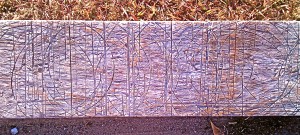It’s 14″ by 62″ by 1.25″ and weighs…a lot. I came across it while on a walk. It was lying on a curb. I’m thinking it had been tossed as trash. I had my phone with me, so I took a picture. It stayed there on the curb another two weeks. I kept telling myself I should drive by and pick it up. Finally, after two weeks, I did. That’s when I discovered it was heavy.
I’m inclined to think the board was part of a saw table. The straight and circular bites into the plywood are deep.
How does this object affect me? When I try to answer that question, the first association I make is to the work of Anselm Kiefer. The length of it, the stretch, evokes the horizon, or a monumental vista, or some span across a mind numbingly long cosmic stretch of time. I think, too, of the merging of myth and material in Kiefer. It’s a material torn from the earth. It’s imposed upon rather than fabricated or tooled. It’s forced to be a witness to the oldest of stories.
In my various interests, the ones in particular that force my Lacanian hand, the word “inscription” appears a good deal. Coupled often with “cut.” It’s the cut that makes meaning. The cut or incision on something too real, in an effort to get it to be read or apprehended as experience. These rings and lines and wrinkles evoke a fundamental motion that is the dance of particles, of energy, the trails followed in the depth of all matter and all life. By what? Who knows? We inscribe as a way to see it. It inscribes us. We inscribe it. It’s wood. It’s skin. It’s the dance at the place where wood and skin are the same.
Cave writing. Aboriginal art. Particle trails in cloud chambers. The segue-ways during The Big Bang Theory. Eroded channels of water. Trade lanes on impossible hermetic maps. The scars and fractal flashing of Lichtenberg lightning. All there.
I’m more a Responder than a Creator, I think. All I can do is look at this thing and wish I had made it.
